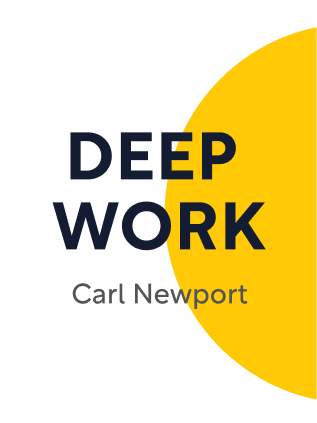

This article is an excerpt from the Shortform book guide to "Deep Work" by Cal Newport. Shortform has the world's best summaries and analyses of books you should be reading.
Like this article? Sign up for a free trial here .
Are you easily distracted by social media? What can you do to improve your relationship with social media? Is taking a detox or sabbatical a good idea?
Social media companies design their apps to be addictive—it makes you feel like you’re being productive (catching up on current events or seeing what family and friends are up to), but in fact, the gains are minor. Cal Newport argues that taking a temporary detox is ineffective and the best way to improve your relationship with social media is to limit your usage.
Here’s how you can evelop a healthier relationship with social media, according to Cal Newport.
Cal Newport on Social Media Distractions
In his book Deep Work, Cal Newport points out that many people are distracted by social media on a daily basis. Social media, and much of the Internet in general, is designed to get you addicted to its content, and it can easily derail you from meeting your true goals.
(Shortform note: In Hooked, Nir Eyal and Ryan Hoover explore the different methods that media companies use to get—and keep—your attention. The authors explain that not only is this information helpful in understanding and breaking your tech addictions, but it can also help you make good habits (like deep work) more “addictive.” For example, you may create a trigger: Each day, your phone’s alarm goes off at 3 p.m. (the beginning of your afternoon slump) and prompts you to put on your sneakers and go for a walk. Over time, this trigger will program your brain to crave the feeling of exercise each afternoon.)
Like shallow work, social media is insidious in that it seems like you’re doing productive things when really the gains are minor. For example, people believe that Facebook connects them to others or surfaces relevant news. This sounds good in principle, but Newport claims that the real result is superficial—the acquaintances you’re making are shallow and unlikely to be the center of your social life. You’ll arrange to see the people you really care about outside of Facebook. Similarly, the news you come across on your feed may be fun to read, but for the most part, it doesn’t move you closer to your major life goals.
Limiting Usage
Newport says that to counteract the distracting effects of social media, some people declare Internet sabbaticals and go completely offline for a month. He doesn’t agree with this method—he says it’s not necessary to be a Luddite, just like artisans don’t forgo all tools made of metal. Social media can be useful if you use it deliberately. Unfortunately, as Newport explains, many people use the “any benefit” argument—that is, a technology tool is justified if it provides any benefit to the user. He argues that this thinking dilutes your focus. Instead, you should concentrate your time only on the most effective tools, instead of spreading it across many somewhat effective tools, in order to become more productive.
(Shortform note: Reviewers have pointed out that Newport has never utilized social media and therefore may not be the best authority to comment on what different platforms can and can’t do for its users. Consequently, his view that Facebook usually only creates shallow relationships feels outdated: It’s not uncommon these days to live and work in cities or countries far from your friends and family. Social media, notably Facebook—as many expat communities report—is a simple way to both establish relationships in your new city and stay in touch with loved ones you’re not able to meet up with in person.)
To begin managing the way you use tech, Newport suggests taking the following steps to examine each of your tech tools in regard to their benefits, cost, and the opportunity cost. This will help you clearly see which tools are worth your time and which aren’t.
1) List Your Goals and Goal-Supporting Activities
First, make a list of your most important goals—professional and personal—and then list the two or three activities that help you progress most toward these goals. Newport notes that these activities should be specific enough to give you direction, but general enough to be repeatable.
- For example, “Do good research” is too vague of a goal to be actionable. “Finish paper A” is a one-time goal that doesn’t suggest a repeatable practice to keep moving you forward. Instead, try to name a specific, ongoing activity such as, “Regularly read the cutting-edge papers in the field.”
(Shortform note: While Newport’s arguments are generally against social media, your goal-supporting activities don’t have to be. For example, reviewers are critical of Newport’s claim that journalists and authors on social media are wasting their time—after all, he says, there are many successful authors without social media accounts. This argument misses the important detail that the authors he names found their success before social media became such a pervasive advertising tool. These days, for many authors trying to break into the industry, establishing a presence on social media is an essential part of marketing their work.)
2) Examine Your Tech Tools
For each of your major tools—for example, Facebook, Twitter, and Reddit—describe how they contribute (or don’t contribute) meaningfully to your important goals.
- For example, if your professional goal is to develop innovative products that solve people’s problems, then spending time on Reddit or marketing yourself on Twitter may be less effective than focusing on the problem area and talking to experts in the field.
(Shortform note: To fully understand a tech tool’s effect on you and your goals, you must be honest with yourself about why you’re using the tool. Research shows that your intent in using social media determines how negatively or positively it will affect your well-being—those who use social media to check out what others are up to develop negative well-being due to constant comparison, while those who use social media to chat with their friends develop positive well-being due to strengthened social bonds.)
If you’re on the fence about how much you need a tool, do an experiment: Quit for 30 days and see what happens. Afterward, consider whether your life would have been notably better if you had been able to use that tool.
- Newport argues that what holds people back from quitting is the conceit that people care what you have to say. In reality, much of social media for most people is a mutual exchange: “Like my stuff and I’ll like yours, too.” It’s not a genuine interaction, and it can be easily replaced by other people. If you quit social media, you may find that you weren’t missed at all. If anyone cares, they’ll get in touch with you another way. (Shortform note: This doesn’t take into account that most people aren’t closely tracking their followers—your absence may go unnoticed, even by people who care about you. Newport’s argument that people who don’t reach out don’t really care about you can make you feel isolated or forgotten, when the real reason for their lack of contact may simply be that they don’t realize you’re not seeing their posts.)
- He says if you quit reading news or participating in online flame wars, you may find yourself feeling more content, and will likely find you’re not at all upset about hearing big announcements a few hours after everyone on social media. (Shortform note: This feeling of contentment is due to physically being less stressed: Studies have shown that receiving constant updates about events (on a global and personal scale) raises your cortisol—stress hormone—levels. When you step away from social media, your cortisol levels return to normal.)
(Shortform note: Breaking out of the dopamine cycle of social media is easier said than done. There will be an adjustment period: Research shows that it takes about eight days for your brain to calm down and become accustomed to a lower level of stimulation. According to psychologist Jonathan Bricker, the most successful way to respond to your inevitable social media craving during this time is not to ignore your craving—this only makes it stronger. Instead, acknowledge your craving and accept its presence. Often, taking the time to go through this thought exercise is enough for the craving to subside.)
3) Find a New Way to Spend Your Time
Tally up the time you spend on each tool that doesn’t support your goal, then think of alternative, goal-supporting activities you could fill this time with. Newport explains that these more meaningful activities are the true opportunity cost of distracting tech tools—the more time you spend on relatively meaningless distractions, the less time you have to work on activities that move you toward what you really want. He suggests finding structured hobbies with defined goals, such as reading a certain number of books or knitting a scarf. He notes two benefits of these types of activities:
- If you accomplish a goal in your free time, you’ll feel more fulfilled than if you spent hours meandering aimlessly on the Internet. You’ll also begin the next day more relaxed and ready to do deep work.
- Goal-supporting activities give your brain a break. You might think that your brain needs “vegging” activities like scrolling Instagram or bingeing Netflix in order to recover from cognitively demanding tasks—but Newport argues that all your brain really wants is change, not rest.
(Shortform note: In Digital Minimalism, Newport explores ways you can “reclaim” your time and attention and refocus on what’s important to you, such as your family, your relationships, and your leisure time. For the most part, he suggests “analog” activities that take you away from your screens, but keep in mind that there are plenty of online activities—such as taking classes, learning new skills, or beating video games—that can help advance you toward different goals.)
4) Keep or Discard the Tool
Newport recommends adopting a tool only if you’re sure the benefits substantially outweigh the negative impact and the opportunity cost. Carefully consider whether it would be better to shift the time spent on each tool to alternative activities.
Most likely, you’ll find that a few significant activities drive most of the progress toward your most important goals. Newport claims that once you discover this, you’ll be able to discard the numerous tasks that aren’t actually productive.
(Shortform note: In Digital Minimalism, Newport adds another step to this process of focusing your concentration—thinking in features. Think of each tool you keep in terms of the individual features useful to you, rather than as a single tool. For example, you might think of Facebook in terms of its Messenger application, event announcements, and several groups you joined to learn guitar. This exercise helps train you to use each tech tool only in its most useful ways, instead of lumping the good and bad uses together.)
Instant Messaging
In Chapter 1, Newport contends instant messaging systems that keep us in constant contact with colleagues mean we never have undistracted moments in which to do deep work. (Shortform note: Newport doesn’t offer a specific antidote as he does for other distractions such as social media—however, his other techniques such as using tools only in ways that support your goals, could apply as well to instant messaging.)
| Tips on Resisting the Distraction of Slack…From Slack Employees Many people blame the instant messaging platform Slack for the havoc instant communication is wreaking on employee focus. However, on his blog, Nir Eyal points out that Slack employees actually have an exceptionally healthy relationship with the product. He chalks this up to several practices: They schedule time for instant messaging: Instead of letting messages ping all day, Slack employees block off time in their schedules for writing and responding to messages. When they need to do uninterrupted work, they set an “away” message that notes when they’ll be available to chat. They use the Do Not Disturb feature: Most Slack employees set their Do Not Disturb feature, which blocks notifications from getting through to them, to turn on automatically after work hours and on the weekends. (Eyal notes that this practice is almost unnecessary: Slack employees have a shared understanding that it’s rude to send messages outside of work hours.) Leaders set a strong example: The foundation of Slack employees’ healthy relationship with instant messaging is the example set by their leaders, who take their role as culture influencers seriously. For example, they regularly remind employees that they’re expected to be out of the office by a certain time every night and should not be working from home in the evening or on the weekend. Leaders are careful not to message anyone outside of office hours, knowing that their employees take cues from them. Instant messaging itself isn’t the problem—it’s the way employees are (or aren’t) trained to use it effectively. As an employee, you can create policies around your instant messaging use. As a manager, you can adopt best practices and demonstrate them to your employees. |

———End of Preview———
Like what you just read? Read the rest of the world's best book summary and analysis of Cal Newport's "Deep Work" at Shortform .
Here's what you'll find in our full Deep Work summary :
- How deep work is critical for performance and productivity
- Why focus is like a mental muscle
- Why willpower isn't as good as a ritual






